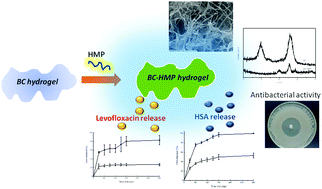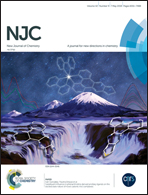Hybrid bacterial cellulose–pectin films for delivery of bioactive molecules†
Abstract
Novel biopolymeric films based on bacterial cellulose (BC) modified with high methoxylated pectin (HMP) were developed for drug delivery. The ability of the films to incorporate an antibiotic, levofloxacin (Levo), was analyzed. Incorporation efficiencies were determined using films with different proportions of HMP (from 0.1% to 2.0%) with a maximum drug payload of 6.23 mg g−1. Characterization studies revealed the existence of a cooperative network between both polymers and deep structural changes in the BC matrix. Besides, the presence of HMP decreased water loss in the BC films from 93% to 75% after 90 min. Additionally, the capacity of the films to incorporate macromolecules was studied using Human Serum Albumin (HSA) as a model protein. The presence of HMP enhanced by more than 3.5 times the encapsulation efficiency (EE) of HSA, and no pH dependence was observed. Release kinetics of both molecules showed hyperbolic profiles with sustained release. In independent experiments, the presence of HMP generated a decrease of around 50% in the release rates of both macromolecules. Additionally, the incorporation of HSA into the BC–HMP matrix modulated the Levo release profile. The antimicrobial activity of Levo released from the BC–HMP–HSA films was confirmed using Staphylococcus aureus. In vitro studies revealed no apparent cytotoxicity of the released compounds in mammalian CHO cells.



 Please wait while we load your content...
Please wait while we load your content...